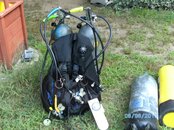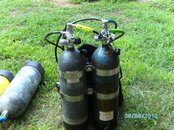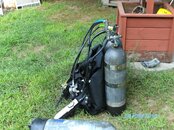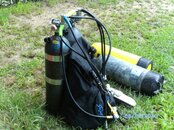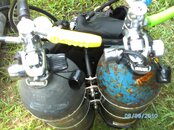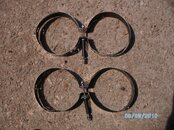Carrying tanks anywhere but on my back appears to me cumbersome and akward.Sidemounted tanks on some of the shore diving I do doesn't seem like a good idea to me. I don't mean to condem something I've never tried, I'm just giving my impressions. I may very well try some kind of slung gas bottles someday just to prove myself wrong. Right now my ID's are looking good and fit my type of diving very well.
It depends on the sidemount system used. The Nomad is intended to be flexible with an eye toward expedition diving where the conditions and demands may vary widely. I have found that with the new ring bungees, a Nomad will carry double tanks very comfortably during a surface walk and they have a much lower center of gravity that helps increase your stability over rough ground, climbing in and out of sinks, on rocks etc. And, as always, you have the option of making two trips with one tank each trip.
Where SM still does not impress me is in off shore boat diving where you may have to board on a ladder in fairly heavy seas. The SM tanks are less solidly mounted and the potentil weight shifts can be de-stabilizing. Worst case though you could remove the tanks, clip them to a gear line and come aboard with no tanks - but that adds work for the crew.
That's almost what I did. Rules of thumb are good but gas management is really governed by the dive and conditions.
I dove independent doubles with travel bands for years - back before sidemounting made independent doubles cool again. I did so because it fit the diving I did very well - any wreck dives of note required travel and renting tanks was the norm with rentable doubles being very rarly encountered - but I none the less took lots of heat for it from the manifold crowd and task loading was frequently cited.
But, as you know, the additional task loading is only two switches per dive.
-----
However, be very careful about winging the gas management if you get into soft or hard overhead environments. Independent doubles only add an extra level of safety if you always ensure you have the gas left in either tank that is
at least equal to the total you used to get to the point you turn the dive (and that still does not takee into account deco requirements, so your "thirds" may need to be a little smaller than actual thirds).
For example, if I have steel 72's slightly overfilled to 2400 psi, I have 69 cu ft per tank split into 800 psi "thirds" of 23 cu ft each. That gives 46 cu ft for penetration, 46 cu ft to return and 46 cu ft in reserve at the end of the dive, split with 23 cu ft in each tank.
Similarly, it leaves 46 cu ft in each tank when I reach the max pentration/turn point, assuming I use the 1/3rd-2/3rds-1/3rd gas switch approach. In that case I will have 46 cu ft left in either tank to make my exit, but it leaves no margin for any delay or deco obligation.
If I reduce the "thirds" to 700 psi , I will reduce the pentration gas to 40 cu ft, but I will increase the end of dive reserve to 58 cu ft, and at the turn point, I would have 49 cu ft left in each tank, adding a 9 cu ft cushion in each tank.
If I further reduce the "thirds" to 600 psi , I will reduce the pentration gas to 34 cu ft, but I will increase the end of dive reserve to 70 cu ft, and at the turn point, I would have 52 cu ft left in each tank, creating an 18 cu ft cushion for the exit.
In other words, reducing your "third" by 100 to 200 psi will add a significant margin of reserve gas in each tank and will only knock a couple minutes off your bottom time.
What 600 psi thirds would then look like would be switching from the left to right tank when I breathed the left tank down to 1800 psi, then breathing the right tank down to 1800 psi, turning the dive and, staying on the right tank, continue to breathe it down to 1200 psi, before switching back to the left tank and breathing it to 1200 psi, at which point I should either be on the surface or on my first deco gas.
In deco diving, this strategy also leaves 34 cu ft in each tank for deco purposes in the event the deco gas is 'lost' and a large reserve is important as the deco time and gas required on back gas can easily double over a 1 or 2 deco gas schedule.



